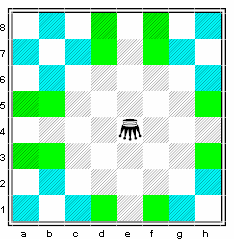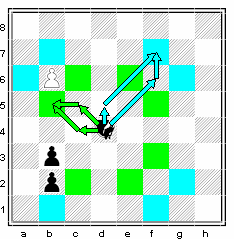Octopus Chess
Octopus Chess features 2 new exotic pieces that possess unusual moving abilities. The game also uses augmented knights instead of regular knights and 5 additional pawns that can be dropped during play.
The new pieces are:
The Octopus: - A powerful crooked slider that controls multiple files, ranks and diagonals.
The Sorcerer Snake: A piece that follows one of two crooked paths to squares that are a Knight's move away or an extended Knight's move away.
The Ninja Pawn:- A stronger pawn can also move sideways anywhere and capture sideways on the enemy half of the board.
The Ninja Pawn is not present in the initial setup but is dropped during play into a vacant space on the second rank.
It can be optionally pushed forward on the same turn.
The Knights are replaced by the Ferz-Knight and the Wazir-Knight which make additional diagonal or orthogonal stepping movements.
Otherwise, the rules are exactly as in orthodox chess except for: Flexible castling (King can castle by moving 1, 2 or 3 (or 4 on Q-side) spaces towards rook, the new pieces, faster pawns and asociated extended en-passant rules.
Setup
 |
The board is set up as follows for the white side (black side will mirror this):
Rook on a1 Wazir-Knight on b1 Bishop on c1 Sorcerer Snake on d1 Queen on e1 King on f1 Octopus on g1 Bishop on h1 Ferz-Knight on i1 Rook on j1 10 pawns from a2 to j2. Note that the lower right square is white, and that kings occupy the same color square. 5 Ninja pawns to be dropped one per turn into empty space from a2-j2 |
Pieces
The Octopus

 |
The octopus can take one of two unobstructed paths:
The Octopus can go to the green squares by taking 1 diagonal step followed by two or more orthogonally outward steps. Or it can go to the blue steps by taking 1 orthogonal step followed by 2 or more diagonally outward steps . The Octopus captures by replacement only . It cannot JUMP, it can only travel via vacant spaces along the specified paths. |
The Sorcerer Snake


 |
The Sorcerer Snake can go to the green squares by taking either 1 diagonal step followed by 1 orthogonally outward step
OR one orthogonal step followed by 1 diagonally outward step.
Since b3 is occupied by a black pawn, it cannot move there. The Sorcerer Snake can travel to blue squares by taking one orthognal step followed by 2 diagonally outward steps OR it can go to the same square by taking 2 diagonal steps followed by one orthogonally outwards. Both paths must be blocked for it not to be able to make it to the destination square. The pawn at b3 blocks one path to a2 and the pawn at b2 blocks the other, so it cannot get to a2. |
The pawn can move from its original position either 1, 2 or 3 vacant squares forward.
If it previously moved only 1 space originally or captured from original position, it can move forward two spaces towards the center.
En-passant is logically applied to meet these changes.
From the middle (rank 5 for white, rank 6 for black), it can step only 1 space forward into the upper half of board, but from thereafter it can go one or two vacant spaces forward.
For example, a pawn can start at e2 push forward to e5 then make one step to e6 then go e8, and promote at e10 in 4 moves!
Note that if a pawn makes the two step pawn move and bypasses an enemy pawn, it can be captured en-passant.
The Ninja Pawn


Movement:
The ninja pawn can always move 1 square up or 1 square sideways
to an empty square regardless of where it is situated on the board.
Thus White can on each turn move from e2-e3, e3-d3 and d3-d5.
From the middle exactly, (rank 5 for white, rank 6 for black), the ninja pawn can move only 1 square forward, but thereafter as soon as it enters enemy territory (the upper half of the board: White rank 6-10, and for black rank 5 - 1), the pawn can go forward either 1 OR 2 empty spaces.
Capture:
Like the standard pawn it can capture one square diagonally up, regardless of which half of the board it is on.
When the ninja pawn is on the top half of board (White rank 6 +, Black rank 5-) , it can also capture one square horizontally.
There is no en passant. It cannot capture another pawn or ninja pawn en passant nor can any other pawn capture it this way.
Promotion:
The ninja pawn promotes on the last row (rank 10 for white, rank 1 for black), to any piece. Promotion to a piece is mandatory so it would cease to be a pawn
in the last row.
Note that like the standard pawn, it can reach the promotion square from its start position in a minimum of 4 moves!
It cannot make a capture on the same turn as the drop.
The Ferz-Knight - moves like a knight or makes one step diagonally.
The Wazir-Knight - moves like a knight or makes one step orthogonally.
Rules
The rules are exactly as in orthodox chess except for:- The new pieces: the Octopus and Sorcerer Snake, the larger board and dropping Ninja Pawns.
- Flexible castling (King can castle by moving 1, 2 or 3 (or 4 on Q-side) spaces towards rook.
-
Faster pawns and asociated extended en-passant rules:
The pawns move 1-multiple spaces towards the middle, then 1 space from middle and then 1 or 2 spaces forward
Notes
This game was derived during the creation of the zillions file for Pick the Piece Big Chess. The original game conceived with these pieces had the different board setup for Pick the Piece Big Chess. It can be found in the main variation of the zillions file here. There is also a subvariation with augmented knights but with the same board setup.The zillions for this game will be coming soon.
 This 'user submitted' page is a collaboration between the posting user and the Chess Variant Pages. Registered contributors to the Chess Variant Pages have the ability to post their own works, subject to review and editing by the Chess Variant Pages Editorial Staff.
This 'user submitted' page is a collaboration between the posting user and the Chess Variant Pages. Registered contributors to the Chess Variant Pages have the ability to post their own works, subject to review and editing by the Chess Variant Pages Editorial Staff.
By Charles Daniel.
Web page created: 2008-10-24. Web page last updated: 2008-10-24
